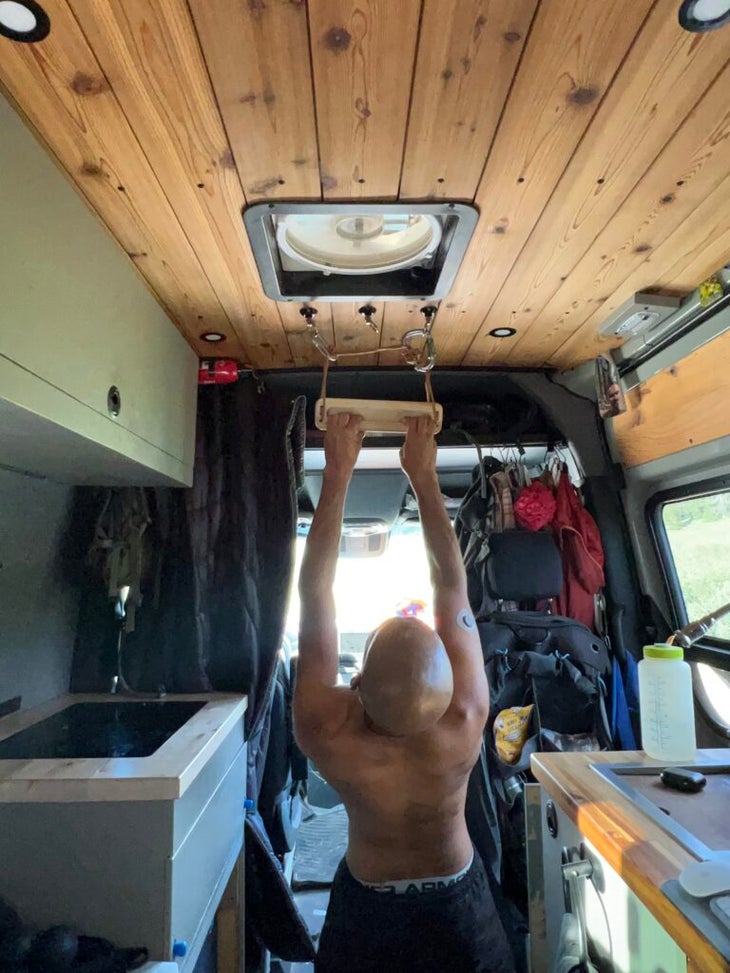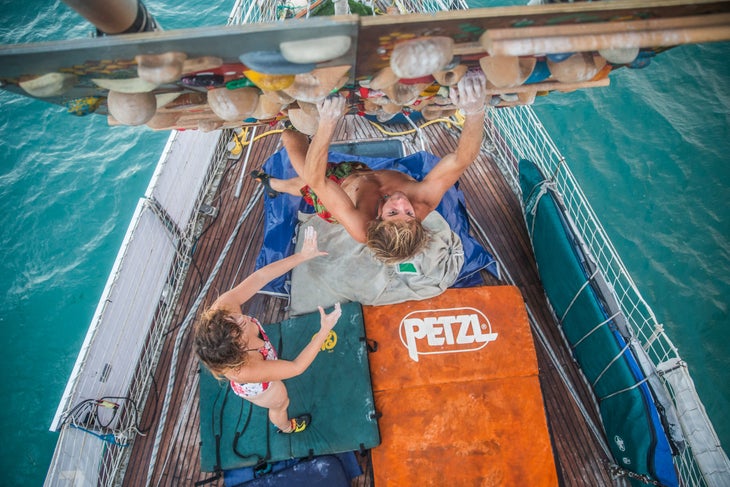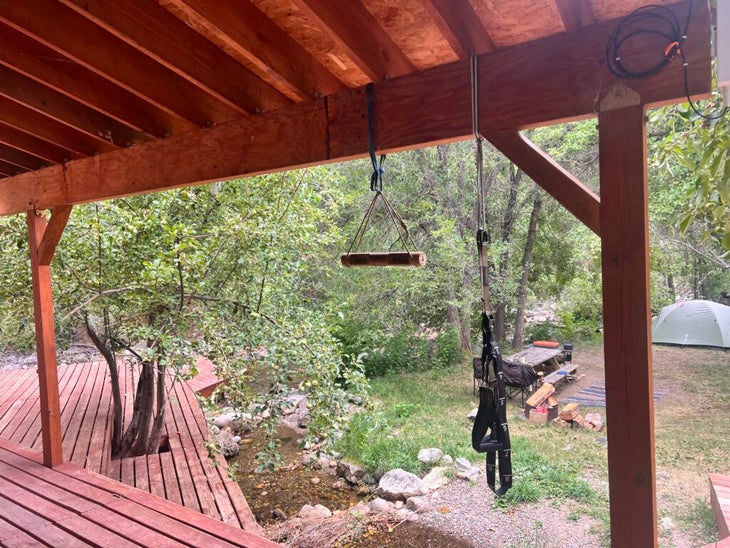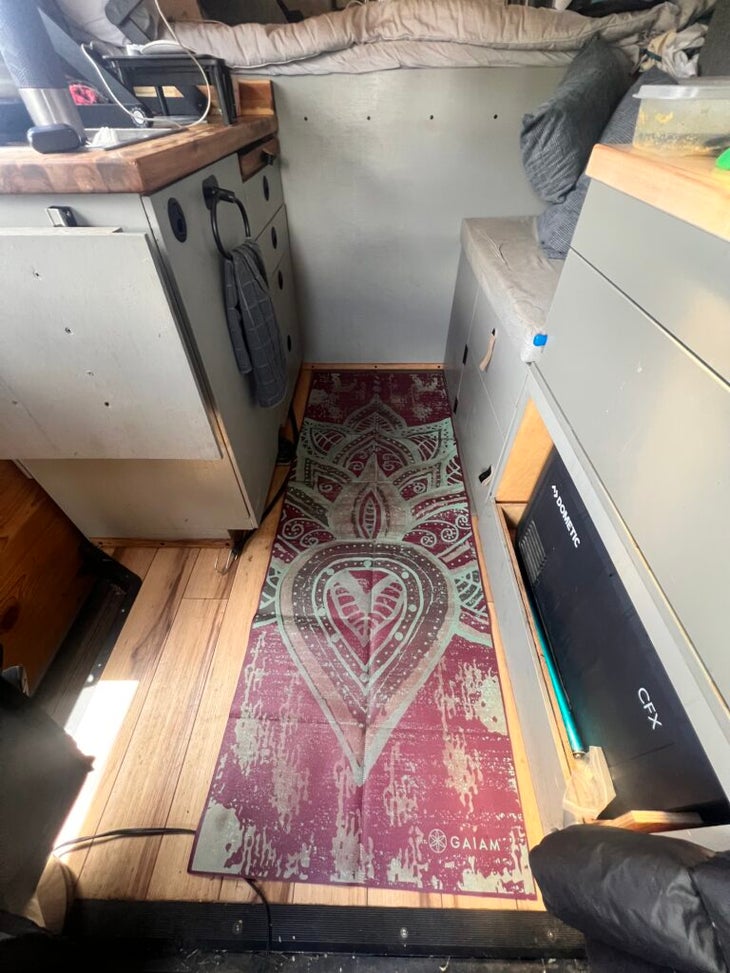“], “filter”: { “nextExceptions”: “img, blockquote, div”, “nextContainsExceptions”: “img, blockquote, a.btn, a.o-button”} }”>
Heading out the door? Read this article on the new Outside+ app available now on iOS devices for members!
>”,”name”:”in-content-cta”,”type”:”link”}}”>Download the app.
Back in my small condo in San Francisco, my “gym” often consisted of a set of dumbbells wedged between the bed and the wall, a hangboard mounted above the doorframe, and a daily mobility flow squeezed between furniture. Like many climbers during the pandemic, I learned to train without fancy setups.
That DIY ethos became essential when I left city life to live and climb on the road last fall. Staying in shape wasn’t just about vanity or chasing grades—it was a necessity. I needed to keep up with rehab from injuries that almost pushed me out of climbing. To avoid backsliding, I also wanted to preserve range of motion and maintain strength. As I traveled through new places, I would often lack the convenience of gyms, yoga studios, or even flat ground.
So I brought the gym with me.
I mounted TRX straps and a hangboard to the ceiling of my van. I squeezed in adjustable dumbbells that I could load or strip down. Luckily, my van aisle is just wide enough for a yoga mat—perfect for a pared-down Ashtanga standing sequence most mornings. While the setup was simple, it works. In fact, it forced me to get clearer on what I really needed.
While on the road this past year, I’ve started noticing the creativity of other climbers living this life. Whether it’s swinging kettleballs at roadside pullouts or doing yoga by a desert campsite, the ingenuity of the portable gym mentality is endless.
In urban areas, climbers adapt in other ways. Once, at a Planet Fitness in Las Vegas (a city with world-class outdoor climbing, but meh climbing gyms), I saw two women improvising with a fingerboard they’d clipped to a squat rack—sneaking in fingerboarding between sets of sumo squats.
If you live and climb on the road—or aspire to one day—I’ve dug deep for the best climber van life training tips. I’ve drilled nomadic pros and I’m sharing my greatest discoveries to help you stay fit wherever you are. Best of all, you don’t need a fancy Sprinter van to take action on this advice. Whether you’re living in the back of your Subaru or sailing across the sea to a big wall objective, here are some ideas for training on the go.

How pro climbers get creative with on-the-go training
I’ve interviewed several pro climbers who’ve managed to stay fit in wanderlust mode. Each example offers guidance for different on-the-go scenarios.
Roving (and sending) senior climbers
Chuck and Maggie Odette, in their 50s and 60s respectively, travel around the U.S. full-time in their van—and they’re still sending 5.13+. In an interview I with the Odettes last year for my podcast Ageless Athlete, Chuck described their itinerant setup in El Salto, Mexico:
“We’d be camped at the parking lot near the cliff and I’d warm up before heading to the wall. After climbing we’d do supplemental work—a crossfit-type of workout with pullups and pushups.”
They also carry BFR (blood flow restriction) bands that Maggie claims helps them recover better for actual climbing days.
This case study in climber fitness shows us that training doesn’t need to be high-volume. It just needs to be specific to objectives.

Staying in shape on the open sea
This January, Seb Berthe made the fourth repeat of the Dawn Wall. He spent a total of eight months on a sailboat traveling and training between Europe and Yosemite while projecting the route. Why a sailboat? To get to Yosemite from Europe with a minimal carbon footprint.
When I spoke with him on Ageless Athlete, Seb described how his training evolved over those multiple ocean crossings. On his first trip to attempt the Dawn Wall in 2022, he admitted that just standing up could be hard as he was often seasick. He brought a fingerboard but admitted that “trying to do max hangs on a moving boat was not ideal.”
So when Seb returned for his second attempt, he adapted. He and his crew installed a spray wall on the deck, and developed a creative new way to train:
“Depending on how the boat was tilting, I had different exercises. Sometimes it was really easy, and sometimes it was really hard. I couldn’t measure anything exactly, but I had to accept that. You can’t always know how strong you are when the floor is moving.”
That constant unpredictability—combined with a moving “mountain,” as he put it—wasn’t just a hindrance. It became a hidden asset. “It’s actually quite good for the joints and muscles,” he said with a laugh. “Maybe a moving hangboard is something people should try.”
Because sessions were short—usually just an hour in the morning, then another in the afternoon—he focused on quality over quantity: “I couldn’t do a five-hour session. So I went really intense. Pure strength and power. And that’s maybe what I needed most.”
In the end, Seb believes the whole experience may have helped him prepare for Yosemite’s most legendary climb in ways no spreadsheet—or stationary training setup—ever could. “It got me more psyched,” he explained. “It put me out of my usual routine. Maybe it helped … or maybe that’s foolish. But I like to believe it.”
It’s hard not to agree with him.
These examples—van lifers, urban creatives, and ocean-bound athletes—point to the same truth: It’s not about having the perfect gym. It’s about solving for what you can do wherever you are.

Tips for climbers training on the road
After living in my van for over a year while climbing and rehabbing, these are the habits and tools that have helped me stay strong, consistent, and injury-free—even without a traditional gym.
- Define your training goal. Are you rehabbing? Building power? Maintaining finger strength? Know your “why” so you can set specific goals to work toward—and develop the on-the-go training setup needed to achieve them.
- Make movement part of your morning. A simple yoga or mobility flow can set the tone for the day. I try to do mine first thing—sometimes right inside the van. I lucked out with just enough space for a yoga mat, but often I’ll unroll it outside at a campsite or even a quiet trailhead. The key is consistency, not perfection—just find a flat spot, breathe, and begin.
- Invest in multi-use tools. Resistance bands, a yoga mat, suspension straps, and adjustable dumbbells cover a lot. I keep mine in one storage bin I can pull out easily. In smaller vehicles, try a collapsible crate or under-bed bin, or stash them around your space. For a hangboard, I drilled hooks to my van ceiling. Alex Honnold had one mounted to his van doorframe. You can even hang one from a tree branch if nothing else is available! Get creative.
- Use your environment. Campsites, chain gyms, climbing gyms, or any rest stop can serve as venues for training. At a rest stop, I’m usually just trying to sneak in a quick session right after snacking and napping—some band work, scapular hangs off my pull-up bar, or yoga stretches. You’re not there to impress anyone—just to move, refuel, and keep going.
- Train around your climbing days. As climbing coach Steve Bechtel recommends, train either before or after your climbing session, or early the next day. Stack your stress, then rest fully—especially if you’re trying to send hard projects.
- Training in public? Don’t be shy. Honestly, nobody cares if you are stretching it out at a train station, a gas station, or the boarding gate at Dulles waiting for your delayed flight. And who knows? You may just inspire others to follow suit.
- Don’t forget recovery. A yoga mat (get the travel-friendly one) and foam rollers (get the mini) can go a long way. I carry a massage gun, too, but admittedly, I never use it. The lacrosse ball works well for some good old self-massage.

Let go of the script when it comes to training
One surprising gift of road life? I’ve stopped obsessing over structured training blocks.
For years, I thought progress required spreadsheets and periodized cycles. But living from a van—where rest days might depend on water availability or driving logistics—I’ve learned to improvise. I’ve discovered that sometimes, less is more.
Some days, it’s a 20-minute bodyweight session before breakfast. Other days, it’s a hangboard workout after climbing. Sometimes, it’s just stretching against my van while getting gas. And often, the most satisfying sessions are the ones I do outside—under the sun, by a river, or with the wind pushing through the trees. There’s something grounding about training to the rhythm of the day, not the clock.
There’s freedom in letting go.
As Seb Berthe told me:
“Being on the boat reminded me to enjoy the process. You’re not always in control, but you can always adapt. And adaptation is part of performance.”
Exactly.
